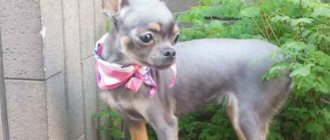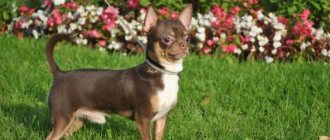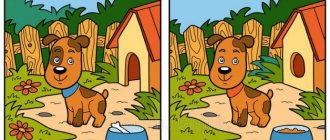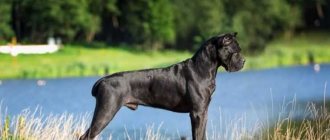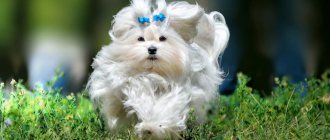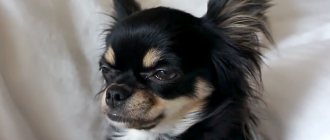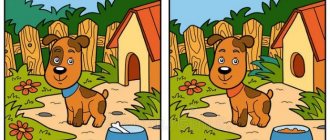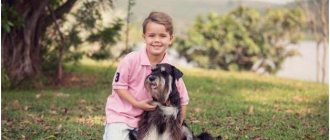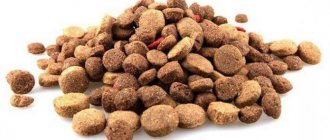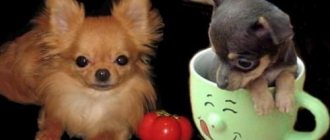Chihuahuas are one of the smallest dogs in the world, characterized by kindness, cheerful disposition, loyalty and charm. They will be ideal pets for city dwellers. The popularity of these dogs is due not only to their compact size, but also to the variety of intrabreed species. Before buying a pet, you should know what types of Chihuahuas there are and which of the existing species are recognized as the breed standard.
Accepted classes of standards
Chihuahuas are companion dogs. They belong to group 9, section 6. In accordance with the standard adopted by the International Canine Association, representatives of this breed must have the following description of appearance:
- rounded apple-shaped skull;
- well-defined stop, rounded and convex forehead;
- short, voluminous at the base and tapering towards the nose;
- compact and well-balanced body;
- horizontal top line;
- a medium-length neck with a slightly pronounced scruff;
- short and strong back;
- lower back with well-developed muscles, wide, strong croup;
- wide and deep chest;
- clearly toned stomach;
- high-set, straight and not too long tail;
- straight and parallel limbs;
- large, erect ears, tapering to slightly rounded tips;
- moderately short nose;
- dry and tight lips;
- scissor or level bite;
- large, round eyes of a dark color.
Any non-compliance with the breed standard is considered a fault of the individual, and serious defects and disqualifying defects include:
- narrow skull;
- small, bulging eyes;
- long muzzle;
- snack or undershot;
- aggression, fearfulness;
- atypical or overly stylized body structure;
- open fontanel;
- cropped, naturally short ears;
- jaw deformation;
- body too long;
- absence of a tail;
- alopecia;
- cryptorchidism.
The breed standard allows for any coat color of the Chihuahua except merle.
False Chihuahua types
The longer we live, the greater the likelihood of meeting pseudo-Chihuahuas at the market, for example English, aboriginal, extreme, etc. How sellers characterize their exotic names is listed below:
- The indigenous type is, as it were, brought from the homeland of the Chihuahua - from Mexico. The main distinguishing feature is a round head, a sharp muzzle, narrow-set eyes and ears. Despite their small size (comparable to the Deer type), the dogs are quite large and overweight. The tail is usually curled like a ram and sometimes lies on the tail. Very similar to the placement of the pug's tail. Most likely this is a cross between a Chihuahua and other breeds. The types of crossbreeds are described in a separate article - Mixed Chihuahua Types.
- England-Chi – oversized build. Massive body and limbs. Rough and thick bones, excess weight.
- Extreme type . Individuals of this type are distinguished by terribly funny small heads, large bulging eyes, excessively thin limbs, and dwarfism. Very similar to the cartoon Chihuahua characters.
- Exotic type . The same Extreme Chicks, only in addition to everything else, characterized by even smaller sizes.
- Classic-Type . They are very similar to the Dire-type Chihuahua, but differ in a rather simple skull shape - maybe an oval, a circle. They also have an unusually blunt or overly long muzzle. Incorrect posture and incorrect angles of the limbs.
Names of species depending on size
Residents of foreign countries were the first to divide representatives of this breed into separate species based on the size of the individuals. Subsequently, this criterion for dividing Chihuahuas into several intra-breed species became widespread. So, in Russia, the classification, which takes into account not so much the size as the weight of these dogs, provides several options:
- standard;
- mini;
- super - mini or micro.
The weight of mini and micro Chihuahuas is not officially standardized, so breeders determine whether dogs belong to one of these species independently, based on their knowledge.
Standard
The body weight of standard Chihuahuas in adulthood is 1.5 - 3 kg. It is this weight that is determined by canine associations as the most optimal for representatives of this breed. Such dogs are compact enough to feel comfortable living in small city apartments and accompanying their owner on trips.
At the same time, they do not show signs of dwarfism, since when breeding them, breeders were not faced with the task of reducing the size of individuals. Standard Chihuahuas, in comparison with smaller representatives of the breed, have the best health and the longest life expectancy.
Mini
Mini Chihuahuas have virtually no exterior differences from standard representatives of the breed, however, some individuals may have signs of dwarfism. Such dogs weigh on average 1-1.5 kg. In general, these dogs are in fairly good health, but are more susceptible to injury and fractures.
Micro
Micro Chihuahuas are dogs whose body weight varies from 500 g to 1 kg. Due to their extremely miniature size, they are prone to developing many different pathologies characteristic of dwarf breeds, in particular hydrocephalus. In addition, this variety has an accelerated metabolism, which causes sensitivity to temperature changes and poor tolerance of both cold and heat.
Only standard bitches can participate in breeding, since pregnancy, childbirth and lactation place too much stress on the dog’s body.
Varieties according to body shape
The high popularity of Chihuahuas has led to the desire of breeders to develop new varieties of the breed, differing not only in size, but also in head shape and build. This is how aboriginal, classic, extreme, Thai, Chinese, English, dwarf, deer-type, stocky Chihuahuas appeared. These varieties, as well as the individuals bred on their basis, are not recognized by any canine association and for the most part are just a commercial ploy.
All deviations from the breed standard lead to health problems and hereditary developmental anomalies in dogs.
The breed standard adopted by the FCI allows only 2 body types for Chihuahuas:
- cobby (eng. cobby - stocky);
- deer (English deer - deer).
Dogs that fully meet all the requirements of the standard are rare. For breeding, breeders prefer to use Cobby type dogs.
Cobby
The Cobby type of Chihuahua is recognized as the standard of the breed. Such dogs must have:
- strong body, wide and deep chest;
- a large head with a convex forehead and a short muzzle, set on a massive neck;
- small, widely spaced erect ears;
- wide-set, large, round eyes;
- strong straight back;
- tucked belly;
- short limbs with developed muscles;
- high-set dense and thick sickle-shaped tail.
This body type is found in both long-haired and smooth-haired representatives of the breed.
Dir
Chihuahuas of this type are strikingly different from cobbies and have a vague external resemblance to Russian toy terriers. Deer type dogs are characterized by:
- thin and fragile physique;
- long and thin limbs;
- elegant exterior;
- small head;
- large, high-set ears;
- long neck;
- smaller than that of a cobby, neck girth and distance between the eyes and ears;
- less dense coat, most often red or fawn in color;
- long thin tail.
This type of Chihuahua moves quickly and easily, but their movements do not have the strength that is inherent in the Cobby type. These dogs are inquisitive and restless, they are wary of strangers, strongly attached to their owner and cannot stand loneliness. Being owners of a high level of heat exchange and metabolism, they feel more comfortable in a warm southern climate. It is believed that the Dir type is smarter and more savvy, which is why it is easier to educate and train.
Cobby and deer types
Chihuahua puppy Bart Simpson on New Year's Eve - "Make a Wish" - Go to the photo album page
Make a wish
The first mention of these types appeared in Ellsworth Howell's book The Complete Chihuahua, popular in the United States in the late 1960s. however, this classification has not received international recognition and has not been adopted as a standard. However, it continues to be used. So, who are “cobbies” and “deers”?
Cobby-type Chihuahuas are short, stocky, with a voluminous head shaped like an apple. They have a fairly massive body, a powerful neck and paws (relative to their size, of course), and thick and dense fur. Cobby-type dogs are characterized as dense, tightly knit. They are generally in good health and are suitable for both exhibition and further breeding.
The dir type is characterized by a narrow chest and elongated muzzle. They really resemble fawns (and the name itself comes from the English deer - deer). Chihuahuas of the “deer type” are lean, light, and mince interestingly when walking (the fact is that the push of their hind legs is not strong enough).
Many breeders do not recognize this division into subtypes at all, saying that Chihuahuas can only be long-haired or short-haired. However, it would not hurt for buyers to know about all the “branches” of the classification in order to consciously make a purchasing decision. Of course, when choosing, it is better to focus not on “types”, but on pedigree.
return to section
Types by coat type
According to the official breed standard, Chihuahuas come in short-haired and long-haired varieties. All other options are considered a defect and deviation from the standard.
Smooth-haired
These dogs have a short, smooth, fleecy and thick coat that fits tightly to the body. The guard hair is soft and silky, but stiffer than that of long-haired individuals. The undercoat is poorly developed or completely absent. The hairs on the tail and around the neck may be slightly longer, but the hair under the throat is thinner. Smooth-haired Chihuahuas need to be brushed weekly with a special rubber glove or a massage brush with soft natural bristles.
Longhair
These Chihuahuas have quite long, thin and soft hair. It is preferable for the hairs to be straight, but the standard allows for slight waviness. Curly hair is considered a serious defect. The undercoat can be developed, thick and fluffy, or completely absent. The fur reaches its maximum length in the area of the ears, belly, tail and back of the limbs, and forms feathering in the “collar” zone.
Long-haired representatives of the breed need to be brushed with a soft-bristled brush every 2 days, and during shedding - daily, using a slicker brush. These Chihuahuas also need to be groomed regularly. Haircuts can be modeling (more often required for show animals) or hygienic, which consists of shortening the hair on the back, belly and sides, removing hair on the ears, paws and around the anus.
Shorthair
Such dogs belong to the so-called transitional type, i.e. their coat is shorter than that of long-haired representatives of the breed, but longer than that of smooth-haired dogs.
Transitional Chihuahuas cannot participate in exhibitions or breeding.
Bald
Chihuahuas that do not have fur are not the result of recent selection; such dogs have always existed. They look unusual and original - their beige or bluish-gray smooth skin without hair gives them a resemblance to elegant porcelain figurines. Hairless Chihuahuas, especially mini or super-mini, require the most careful care and monitoring of their health.
How to choose a puppy
There is no specific standard for additional Chihuahua breed types, so they may not be exactly like those listed in reference books. A problem may arise if the dog is not purchased from. When buying a puppy, you need to pay attention to its weight: if it is small, then the pet may be sick, like its parents. A three-month-old cobby weighs half a kilo, but then the dog will rapidly gain weight.
When purchasing a pet, you need to carefully examine it and feel its belly for bloating. You should check the condition of your ears, which should be clean and free of unpleasant odors. Purebred representatives of the Cobby Chihuahua are not found in nature, therefore they have the features of both varieties of the standard class. When choosing a pet, you need to study the track record of its parents, including their participation in exhibitions and awards.
Even a non-purebred animal like a cobby can become a true friend and companion. You should constantly look after your pet, bring him joy, pamper him, and not forget to educate him at the same time. Each purebred Chihuahua is individual, but it absorbs the love of its owner like a sponge and responds with devotion.
What do the varieties have in common?
Despite their size, build and coat length, absolutely all Chihuahuas make ideal pets and are suitable for keeping even in small apartments. All subtypes of these dogs are characterized by:
- intelligence and intelligence;
- devotion to the owner;
- affectionate disposition;
- courage.
Representatives of this breed do not require long walks and great physical activity, they do not require labor-intensive care and are suitable for people leading a sedentary lifestyle.
What is the difference?
Both mini and standard Chihuahuas can be born in the same litter and are in no way different from each other in the first few weeks. As the puppies grow older, it becomes noticeable that some develop and gain weight faster and more intensely than others, and already 2 weeks after birth they are almost 2 times larger than their littermates in size.
Representatives of these species have practically no differences in appearance: they have the same body type, shape of the head, paws, ear set and length of fur. The only difference between them is weight. In addition, mini Chihuahuas are more likely to have health problems, are more susceptible to various injuries and fractures, and have a lower life expectancy.
What does a stocky "type" look like?
When purchasing a puppy, you look at its behavior, appearance and, of course, get what you want. But how can you avoid making mistakes and choose exactly the dog you need? The Cobby type Chihuahua has the following characteristics:
- Large and round head, resembling an apple;
- Shortened muzzle;
- Large eyes and an upturned nose are also called “baby face”;
- Small ears, but wide at the base;
- Short legs, but dense;
- Large chest;
- The distance between the eyes and ears is noticeably wider than that of dirs;
- The tail is more compacted at the base and narrowed at the end, short;
- The body is powerful and muscular;
- Dense undercoat and thicker coat;
- The back is straight;
- The movements are rougher and the stride is wider, thanks to the push of the hind legs.

